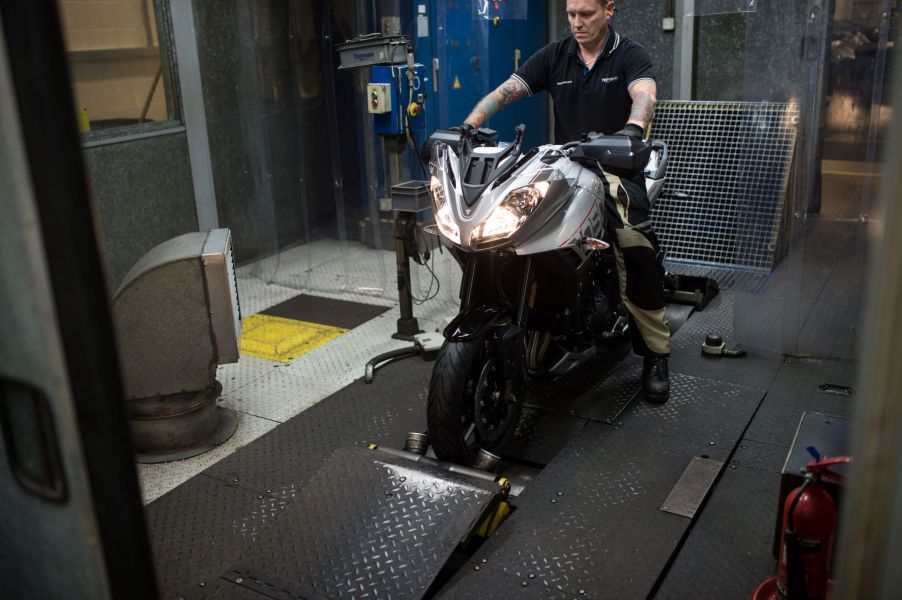
Why Are Some Motorcycles Missing Horsepower and Torque Ratings?
Compared to what supercars put out, a 200-hp superbike like the BMW S 1000 RR might seem almost quaint. Some new hot hatches put out more power, after all. But then, a motorcycle doesn’t need as much horsepower as a car because it’s so much lighter. Case in point, my $4,300 2012 Street Triple R has roughly the same power-to-weight ratio as a multi-million-dollar McLaren F1.
However, comparing motorcycle specs like horsepower and torque ratings isn’t always easy. Depending on the model, it might even be impossible for the average consumer. That’s because not every manufacturer lists all of their bikes’ horsepower and torque figures. But why is that?
Measuring motorcycle horsepower and torque isn’t as simple as it seems

First, it’s important to note that just because a company doesn’t list a specific motorcycle’s horsepower and torque ratings doesn’t mean that it doesn’t know them. After all, even in the US, motorcycles must be emissions-tested. And like cars, that involves putting them on a dynamometer, aka a ‘dyno.’ But dynos aren’t designed expressly for emission tests: they’re also for measuring performance.
As with car-specific ones, motorcycle dynos generally come in two forms. Enthusiasts are likely familiar with chassis dynos, which calculate the horsepower and torque at the rear wheel, RideApart explains. But manufacturers typically use engine dynos, which attach directly to the engine via the flywheel and crankshaft. The former are like treadmills that the motorcycle spins. A computer then converts the measured force to torque and calculates horsepower from that and the engine RPM. Meanwhile, the latter spin the engine directly to a set RPM and calculate torque and horsepower from the power draw.
Herein lies the discrepancy. Car and motorcycle manufacturers typically report crank horsepower and torque. The drivetrain, though absorbs some of that output, resulting in lower rear-wheel figures. But to be fair, the industry knows this. There’s even a general guesstimate of 10-15% drivetrain loss on the car side of things.
However, that figure doesn’t necessarily work for motorcycles. That’s because, EVs aside, all cars rely on solid driveshafts to send power to their wheels. But bikes can have chain or belt drives instead—and they have different loss levels. And that’s before getting into how changing gear ratios, axle ratios, and sprockets manipulate rear-wheel torque ratings.
Also, dyno results aren’t always consistent for the same vehicle. Changes in ambient temperature, humidity, altitude, and so on can affect the results. And while correction factors can accommodate for these variables, they’re not always consistent from dyno-to-dyno or company-to-company, RideApart notes.
Exact motorcycle horsepower and torque ratings aren’t required or necessary in the US
However, even with this uncertainty, car companies regularly list their vehicles’ horsepower and torque figures. So, why isn’t that as common on the motorcycle side of things?
That’s not to say motorcycle manufacturers don’t list official horsepower and torque ratings here at all. For example, Harley-Davidson provides both figures for the new Pan America and Sportster S. Indian does the same with the FTR. However, both brands only list the torque ratings for their other cruiser motorcycles.
This seeming lack of information doesn’t stop there. Kawasaki, for example, doesn’t list the supercharged Ninja H2’s horsepower on its website, just its torque output. And it doesn’t even say that for the smaller-capacity Ninjas. Meanwhile, Suzuki has official figures for the 2022 Hayabusa, but they’re not listed on its US website. In contrast, Ducati freely displays all its motorcycles’ horsepower and torque ratings.
So, why these discrepancies? Officially, there’s no reason. But there are a few possibilities. For one thing, companies might be worried about the potential legal and/or insurance backlash. It’s why Japanese OEMs signed the gentleman’s agreement after the first Hayabusa debuted, after all.
Focusing on the cruisers, horsepower typically isn’t as important as torque, and maximizing the latter means sacrificing some of the former, Cycle World explains. So, it doesn’t matter that air-cooled V-twins don’t make as much horsepower as their liquid-cooled equivalents. Still, potential buyers might not appreciate seeing those lower numbers. This might also explain why small-capacity sportbikes don’t list their horsepower and torque figures, but larger ones sometimes do.
But speculation aside, there’s simply no law that requires motorcycle companies to list their bikes’ horsepower and torque ratings. So, unless the segment demands the information, there’s no impetus to provide it.
These specs matter significantly more for overseas riders, though
At least, that’s the case in the US. But overseas, especially in Europe, things are different. And it has to do with the different types of motorcycle licenses.
Here in the US, once you pass your test—or take the MSF course—and get your license, you can ride any bike you want. Big, small, powerful, economical, it doesn’t matter. But that’s not the case in the UK, MCN explains. For one thing, you must be at least 17 years old, rather than 16 like in most US states. Secondly, the UK has Compulsory Basic Training (CBT) certificates, rather than permits. And thirdly, before you get a full license, you go through some provisional stages.
The first stage after you get your CBT is the A1 motorcycle license, which limits you to 125cc bikes with no more than 15 hp. And after your 19th birthday, you can get an A2 license, which raises the horsepower bar to 47. It’s only upon getting the full A license at 21 that the UK lifts all motorcycle horsepower restrictions.
These licensing laws give motorcycle companies an incentive to publish horsepower and torque ratings. After all, they need to make sure that they and prospective buyers are obeying the rules. And since even the small-capacity models need to have official figures, it makes sense to publish them for the rest of the lineup, too.
Follow more updates from MotorBiscuit on our Facebook page.


